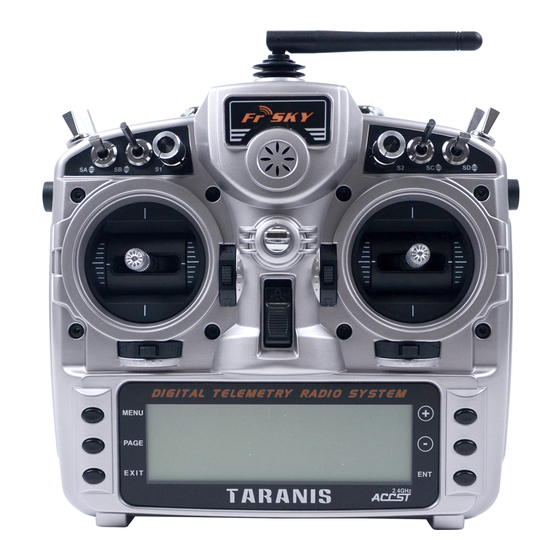
Summary of Contents for FrSky Taranis
- Page 1 F3F Setup for FrSky Taranis Version 4.0 Setup Guide Mike Shellim 28 Sept 2016 Copyright © 2016 Mike Shellim...
-
Page 2: Table Of Contents
Contents Introduction ................................3 ZIP package contents ............................3 What you’ll need ............................... 3 Overview of features ..............................4 Assignments ................................5 Flight control assignments ..........................5 Channel assignments ............................5 Flight modes ................................5 Main flight modes ............................. 5 ‘Calibration’... -
Page 3: Introduction
The Taranis is an amazingly flexible radio. However creating that perfect F3F setup requires advanced skills in OpenTx. F3F Setup for Taranis gives you a competition-proven setup without the hassle of programming from scratch. It offers a simple interface for racing, with real-time adjustment of key mixes for rapid trimming. -
Page 4: Overview Of Features
Overview of features First, a quick run through the main features: Flight modes There are four flight modes: Climb, Normal, Reflex and Landing. Mixers are activated automatically on change of flight mode: Spoiler(crow) Snapflap Camber Reflex Combi Climb Normal Reflex Landing... -
Page 5: Assignments
Assignments Flight control assignments Rudder, Elevator, Spoiler and Throttle are assigned according to stick mode ( menu). MODEL SETUP The throttle stick is used for spoiler. Secondary controls are as follows: Control Function Rudder trim Diff Throttle trim Snapflap volume (Normal and Reflex modes) Spoiler compensation (Landing mode) Rotary knob S1 (X9D), F1 (X9E) Snapflap expo... -
Page 6: Installing F3F Setup In Your Transmitter
Establish communication with your PC: switch on the transmitter whilst pressing inwards on the horizontal trim levers. Then using a suitable USB lead, connect the Taranis to the computer. The Taranis’ SD card should appear as an external drive. -
Page 7: Set Servo Rotation
Set servo rotation The first task is to set the direction of rotation of the servos: Switch on the transmitter (do not power up the receiver yet) Enter CAL mode. The tx will cheep every 3 seconds. Set switch SA to middle Open the menu OUTPUTS... - Page 8 Channel Calibration procedure CH 4 – Lt Flap Start by calibrating left flap (CH4). You’ll set end points only (ignore flap neutral). Enter CAL mode Set switch SA to middle position In the menu, highlight CH4 OUTPUT Skip to curve field ‘CV14’, and press [long ENTER] to open curve editor o Throttle stick back (↓), adjust point 1 for lower end point.
-
Page 9: Backup Your Eeprom
X-Tail Calibrate rudder (applies to X-or T- tail only) CH 6 – Rudder Check you’re still in CAL mode In the menu, highlight CH6 OUTPUT Skip to curve field ‘CV16’, press [long ENTER] to open curve editor o Rudder stick to centre, adjust point 2 for centred rudder o Rudder right (→), set point 3 for max right movement o Rudder left (←), set point 1 for max left movement Check equal travel left/right... -
Page 10: Configuration Part 2 - Setting Up Travel And Mixing
Configuration part 2 - setting up travel and mixing Watch your ship comes to life! You’ll make these adjustments using the regular flight modes. Control / mix Adjustment point Adjustment procedure Set the default aileron movement. Focus on the up-travel Ail rate/expo INPUTSIAil (down-travel is governed by Diff adjusted via rudder trim) - Page 11 Control / mix Adjustment point Adjustment procedure GLOBAL.VGV3(AiCamb)FM2 In this step, you’ll set both the flap and aileron movement for SpoilerFlap GLOBAL.VGV4(FlCamb)FM2 spoiler (crow). Start with flaps: SpoilerAil 1. Select Landing mode 2. Open the GLOBAL.V menu, highlight GV4 3. Skip to the FM2 column 4.
-
Page 12: Dynamic Mix Adjusters
Dynamic mix adjusters A summary of the mix adjusters for trimming out your ship in flight. Make a copy for the field! Adjustment Adjuster Flight modes Notes Aileron Diff Rudder trim [all] Rudder trim right = more roll response/less diff. Range of adjustment = 10 - 70%, trim centre = 40%. -
Page 13: Using 'Instant Spoiler' + 1 Switch
9.1.2 Using ‘Instant Spoiler’ + 1 switch In this configuration, Landing mode is selected automatically as the crow is deployed. A single 3- position switch is used to select the remaining flight modes. The table below shows the necessary adjustments. Substitute your chosen 3-position switch for SwMain: Menu point Setting... -
Page 14: Identifying Mistakes
Identifying mistakes With OpenTx, it’s easy to make mistakes with data entry, and there is no Undo button. Fortunately, it’s quite easy to identify mistakes. The secret is to use the menu in Companion. COMPARE FILES Start Companion Open the (unedited) .eepe file Open your working EEPROM Open the window, then drag the corresponding models into it.

















Need help?
Do you have a question about the Taranis and is the answer not in the manual?
Questions and answers